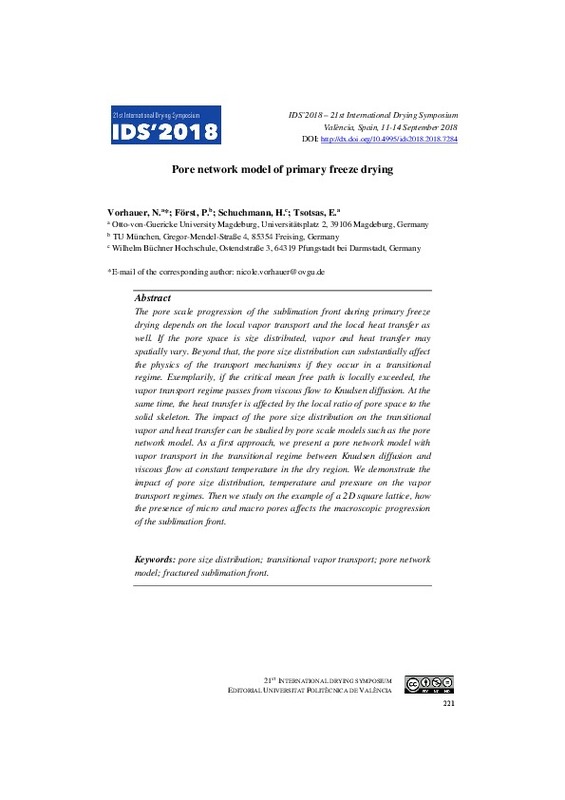JavaScript is disabled for your browser. Some features of this site may not work without it.
Buscar en RiuNet
Listar
Mi cuenta
Estadísticas
Ayuda RiuNet
Admin. UPV
Pore network model of primary freeze drying
Mostrar el registro sencillo del ítem
Ficheros en el ítem
| dc.contributor.author | Vorhauer, Nicole
|
es_ES |
| dc.contributor.author | Först, P.
|
es_ES |
| dc.contributor.author | Schuchmann, H.
|
es_ES |
| dc.contributor.author | Tsotsas, E.
|
es_ES |
| dc.date.accessioned | 2019-02-27T07:09:41Z | |
| dc.date.available | 2019-02-27T07:09:41Z | |
| dc.date.issued | 2018-09-07 | |
| dc.identifier.isbn | 9788490486887 | |
| dc.identifier.uri | http://hdl.handle.net/10251/117394 | |
| dc.description.abstract | [EN] he pore scale progression of the sublimation front during primary freeze drying depends on the local vapor transport and the local heat transfer as well. If the pore space is size distributed, vapor and heat transfer may spatially vary. Beyond that, the pore size distribution can substantially affect the physics of the transport mechanisms if they occur in a transitional regime. Exemplarily, if the critical mean free path is locally exceeded, the vapor transport regime passes from viscous flow to Knudsen diffusion. At the same time, the heat transfer is affected by the local ratio of pore space to the solid skeleton. The impact of the pore size distribution on the transitional vapor and heat transfer can be studied by pore scale models such as the pore network model. As a first approach, we present a pore network model with vapor transport in the transitional regime between Knudsen diffusion and viscous flow at constant temperature in the dry region. We demonstrate the impact of pore size distribution, temperature and pressure on the vapor transport regimes. Then we study on the example of a 2D square lattice, how the presence of micro and macro pores affects the macroscopic progression of the sublimation front. | es_ES |
| dc.format.extent | 8 | es_ES |
| dc.language | Inglés | es_ES |
| dc.publisher | Editorial Universitat Politècnica de València | es_ES |
| dc.relation.ispartof | IDS 2018. 21st International Drying Symposium Proceedings | es_ES |
| dc.rights | Reconocimiento - No comercial - Sin obra derivada (by-nc-nd) | es_ES |
| dc.subject | Drying | es_ES |
| dc.subject | Dehydration | es_ES |
| dc.subject | Dewatering | es_ES |
| dc.subject | Emerging technologies | es_ES |
| dc.subject | Products quality | es_ES |
| dc.subject | Process control | es_ES |
| dc.subject | Environmental | es_ES |
| dc.subject | Evaporation | es_ES |
| dc.subject | Sublimation | es_ES |
| dc.subject | Diffusion | es_ES |
| dc.subject | Energy | es_ES |
| dc.subject | Intensification | es_ES |
| dc.subject | Pore size distribution | es_ES |
| dc.subject | Transitional vapor transport | es_ES |
| dc.subject | Pore network model | es_ES |
| dc.subject | Fractured sublimation front | es_ES |
| dc.title | Pore network model of primary freeze drying | es_ES |
| dc.type | Capítulo de libro | es_ES |
| dc.type | Comunicación en congreso | es_ES |
| dc.identifier.doi | 10.4995/IDS2018.2018.7284 | |
| dc.rights.accessRights | Abierto | es_ES |
| dc.description.bibliographicCitation | Vorhauer, N.; Först, P.; Schuchmann, H.; Tsotsas, E. (2018). Pore network model of primary freeze drying. En IDS 2018. 21st International Drying Symposium Proceedings. Editorial Universitat Politècnica de València. 221-228. https://doi.org/10.4995/IDS2018.2018.7284 | es_ES |
| dc.description.accrualMethod | OCS | es_ES |
| dc.relation.conferencename | 21st International Drying Symposium | es_ES |
| dc.relation.conferencedate | Septiembre 11-14, 2018 | es_ES |
| dc.relation.conferenceplace | Valencia, Spain | es_ES |
| dc.relation.publisherversion | http://ocs.editorial.upv.es/index.php/IDS/ids2018/paper/view/7284 | es_ES |
| dc.description.upvformatpinicio | 221 | es_ES |
| dc.description.upvformatpfin | 228 | es_ES |
| dc.type.version | info:eu-repo/semantics/publishedVersion | es_ES |
| dc.relation.pasarela | OCS\7284 | es_ES |








